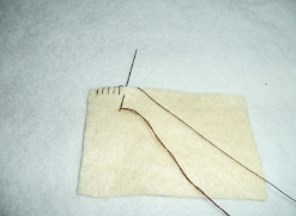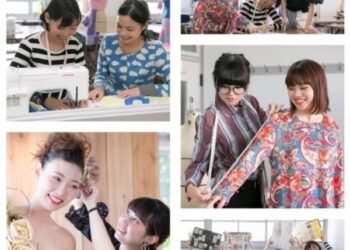To be able to get interesting clothes, of course we also need complementary materials and other accessories. In addition, these other equipment and accessories serve to increase the value of clothing benefits as well as the selling value if indeed the garment is to be marketed.
Here are the necessary supporting gear and accessories on clothing:
1. Zipper
Zippers serve as openings on clothing, be it for front openings or rear openings. Zip brands and models also vary greatly, depending on their usability.
The types of zippers are:
a. Regular Model Zipper
This regular model zipper is a zipper that we mostly find on everyday clothes, for example on schoolchildren’s uniform pants and skirts. This regular zipper has many color options, the size is also long and short. Starting from 15 cm, 20 cm, up to 45 cm or 50 cm. this zipper is mounted using stitches visible from the outside.
Regular zipper
b. Japanese Zipper
Japanese zippers are sewn from inside the fabric, so the seams are not visible from the outside. Japanese zippers are usually mounted on blouses, both at the front and back. To sew japanese zippers are required special machine shoes, so that the installation results are better and neat.
Japanese Zipper
c. Metal Zipper
As the name suggests, the metal zipper of the teeth is made of metal or metal. This zipper we used to find on jeans. The metal zipper is larger and stronger than a regular zipper.
Metal Zipper
d. Large Plastic Zipper
Large plastic zippers are usually attached to jackets. The zipper of this model is usually separated between the right side and the left side. For installation, the right side zipper is inserted into the puller section. When the position is right, then the zipper can be closed and opened according to its function. Due to its use on jackets, this zipper shape is larger and stronger, although it is made of plastic.
Large Plastic Zipper
2. Shirt Buttons
Just like zippers, shirt buttons also have varying shapes. The installation of the shirt button should also pay attention to the rules, namely the installation on the men’s clothing, the right side is the buttoned side, while the left side is the side for the buttonhole. Similarly, the pairing of buttons on women’s clothing is the left side of the button, while the other side is where the buttonhole is.
Some of the various forms of shirt buttons that are often used in clothing are such as:
a. Perforated Buttons
Perforated buttons are made of hard plastic and we used to meet on men’s shirts. Perforated buttons have two or four holes as a place for thread passing. Perforated buttons can be installed using hand sewing or sewing machines. The shape of the perforated buttons is in the form of rounds, squares, even triangles.
Perforated Buttons
b. Legged buttons
Legged buttons, some made of metal and plastic. The legged button has a hole where the thread inserts attached to the back of the button, the shape is similar to the foot. In addition to serving as a cleavage cover, legged buttons can also be used as accessories or clothing ornaments.
Legged buttons
c. Button Press
Button button press we used to meet on the jacket. The snap button consists of two parts, namely the concave and convex parts. The button locks if both are pressed, but will detach when pulled. Kacing snap there is a small size made of stainlesteel. One part is a thin button, and the other is a hollow.
Button Press
d. Fabric Cover Button
Fabric Cover Button is a button wrapped in fabric. The motif and color of the fabric is usually similar to the fabric that will be sewn clothes. The hole for the thread path is at the back of the button.
fabric cover button
e. Loop Buttons
A loop buttons is a button that is paired with a button housing in the form of a cloth folded loop. Buttonholes are not made by punching holes in the fabric, so they are suitable for thin fabrics.
Kancing sengkelit
f. Chinese Buttons
Chinese buttons are buttons made of koor rope material. The koor strap is made into multi-shaped vertices. The button house is also made of the same material.
Chinese Buttons
3. Hook and Eye Sewing
Hook and Eye Sewing consists of two parts, namely the transport part and the transport part. Hook and Eye Sewing are large and small. Hook and Eye Sewing that are small we usually find as fastening on bras, longtorso, and also opening restraints at the end of zipper installation. While the oversized Hook and Eye Sewing is usually attached to the waistband of pants or skirts.
Hook and Eye Sewing
4. Padding (Shoulder Pads)
Padding (shoulder pads) is a complement to clothing making. Padding is usually made of foam and cotton. The function of the padding is to elevate the shoulder to make it more interesting.
The use of shoulder pads should also not be arbitrary. The choice of shoulder pads must be adjusted to the shoulders of the wearer. The shape of the shoulders that goes down should be chosen with a rather thick shoulder pad, so that after the clothes are worn later, the shoulders look more sloping / broad. Whereas for sloping shoulders, the selection of shoulder pads should use thin shoulder pads. Besides being adjusted to the shape of the wearer’s shoulders, the use of padding must also be adjusted to the type of clothing. Here are the types of padding according to the clothes you want to put on:
a. Special Padding Attached to Suits
Padding that is attached to the coat is usually used under the croton layer, so that the padding is not visible from the outside. This padding is made from a mixture of wool and cotton fibers stacked into several layers.
b. Special Padding Attached to Sleeveless Dress or Blouse
Padding for dresses and blouses varies indensity, ranging from density 1 cm, 1 1/2 cm, 2 cm, 3cm, to 5 cm. Usually padding is made of foam.
c. Special Padding Mounted on Long Sleeves and Raglan Sleeves
This type of padding is often referred to as bowl padding.
Before pairing on the shoulders, padding made of foam should be wrapped in a thin cloth (it can also be made of vuring), which has a similar color to the fabric, so that the padding installation is inconspicuous and looks more compatible.
Padding (Shoulder Pads)
5. Bisban/Bias tape
Bisban / bias tape is a complementary accessory in making clothes and other daily items, such as bags and wallets, which are in the form of a long small cloth resembling a ribbon. So that the bisban is often referred to as a ribbon. The function of the bisban is to cover the edges of the fabric to make it look neater and “cute”. Apart from finishing the stitches to make them stronger, the bisban can also be applied as decoration.
Bisban is usually mounted on curved parts, such as the neck or arms. That’s why the bisban is deliberately made elastic. Types of bisban there are three kinds, namely single bus, double busban, and commercial busban (ready to use).
A single bisban is often sewn one side with the rim of the bus, right on the clothing sewing line, along with the good part. But it can be oppressed machine from above on a good part. Double bisban is often sewn in tiras section of the busban on the tiras part of clothing. Double bisban is commonly used in garments with thin materials. While commercial bisban (ready to use) is the easiest to use, because it is ready to install or ready to sew.
6. Hand Sewing
Sewing by hand actually has the same principle as sewing using a sewing machine. It’s just that when sewing by hand it takes patience, precision, and neatness, so the stitches look good.
To be able to sew by hand, we need to know what the basic stitches are used for sewing. Some of the basic stitch types are:
a. Basting Stitch
Basting Stitch is a very simple form of stitch. Basting Stitch seam strength is very lacking, because indeed the function of Basting Stitch is only as a temporary puncture. Basting Stitch is used to combine two fabrics that will be sewn so that the position does not shift when sewn. When finished stitching, Basting Stitch can be removed again.
Basting Stitch
b. Japanese Binding
Japanese Binding is a main stitch used in sewing clothes. The shape of Japanese Binding when viewed from the top of the fabric is very similar to the shape of the machine seam, but when viewed from below it looks less neat because it is indeed hand stitching. Japanese Binding is permanent, so it is stronger stitching than stitch appeal.
Tusuk tikam jejak
c. Cross Stitch
As the name implies, cross stitch the form of two intersecting lines. cross stitch is used to sew the edges of the fabric.
Cross Stitch
d. Feston Stitch
Feston stitch is a type of stitch used to combine two fabrics or smooth the edges of the fabric. Feston stitch can also serve as an ornamental seam. While the application of Feston stitch in clothing is to sew buttonholes. By sewn using Feston stitch, the buttonhole does not fall apart and will look neat.
festoon
e. French Knot Stitching
The french knot stitch is the final stitch used to end the stitch. Knot is done on the back of the fabric so that it is not visible from the outside. By using a knot, the stitch will not come off easily.
Finished for Sewing Supporting Equipment and Accessories… May it be helpful and thank you 🙂































